Project Management Methodologies and Stakeholder Analysis for TFL
VerifiedAdded on 2023/06/12
|11
|1944
|217
Report
AI Summary
This report identifies effective project management techniques and methods for Transport for London (TFL). It explores methodologies like Agile and Waterfall, recommending the Waterfall technique for its ability to divide road projects into manageable sections. A network diagram illustrates task interrelations, highlighting the importance of deadlines and resource utilization. Stakeholder analysis categorizes key individuals based on power and interest, emphasizing the need to satisfy investors, board members, society, and employees. Risk assessment identifies potential issues and mitigation strategies, while task six focuses on promotion, quality control, and performance metrics. The report concludes by emphasizing the importance of stakeholder support and risk mitigation for project success. Desklib provides a platform to access this and other solved assignments for students.
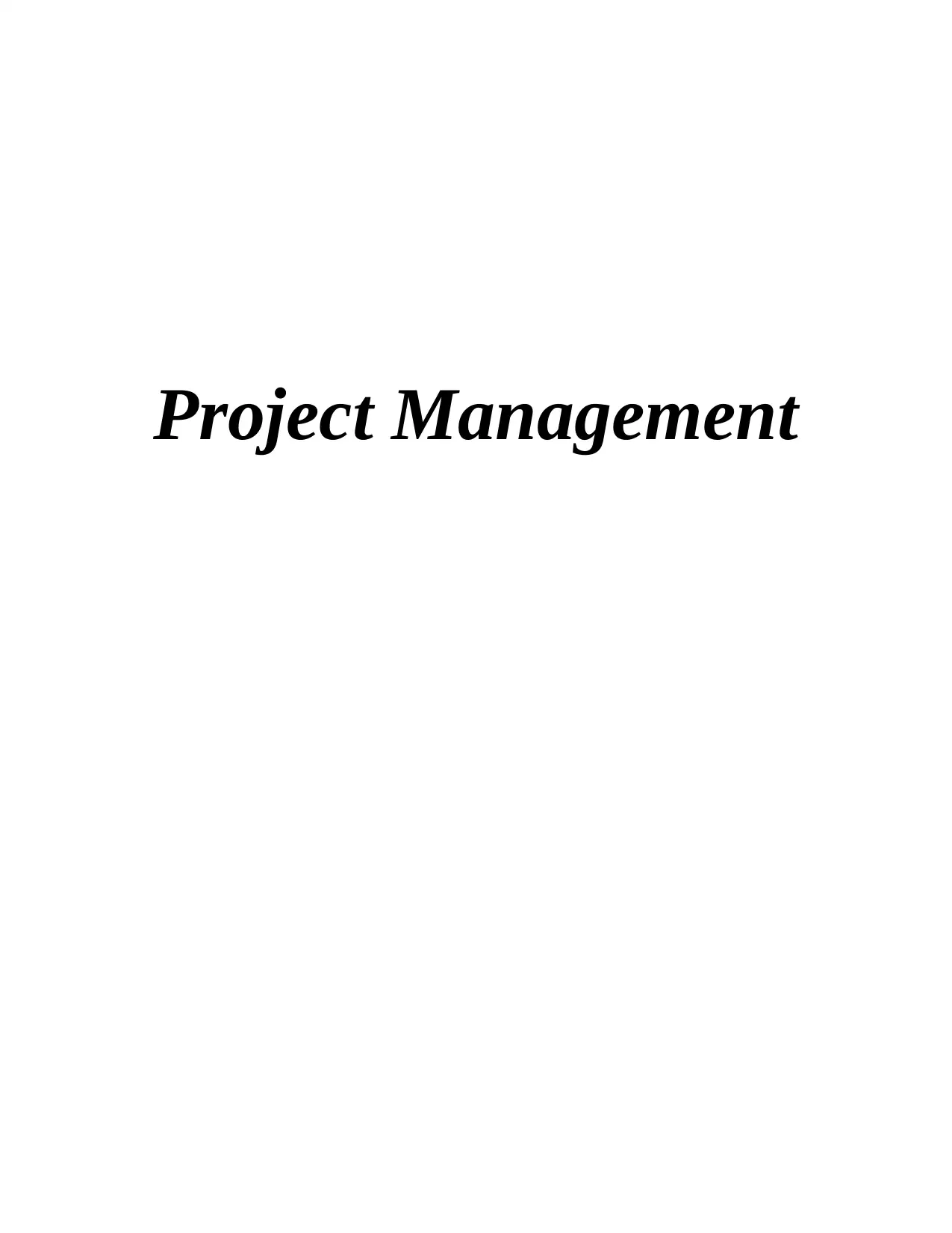
Project Management
Paraphrase This Document
Need a fresh take? Get an instant paraphrase of this document with our AI Paraphraser
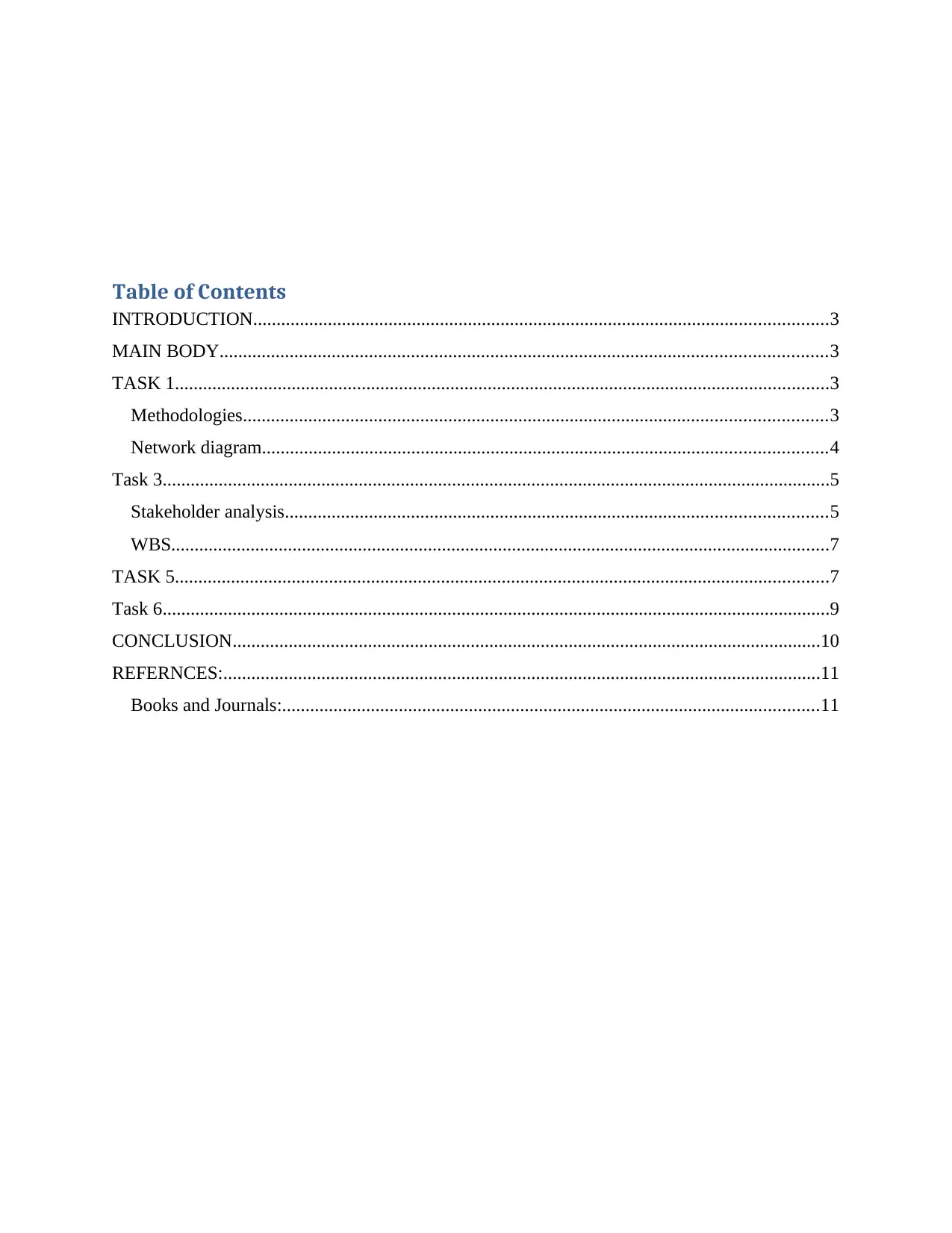
Table of Contents
INTRODUCTION...........................................................................................................................3
MAIN BODY..................................................................................................................................3
TASK 1............................................................................................................................................3
Methodologies.............................................................................................................................3
Network diagram.........................................................................................................................4
Task 3...............................................................................................................................................5
Stakeholder analysis....................................................................................................................5
WBS.............................................................................................................................................7
TASK 5............................................................................................................................................7
Task 6...............................................................................................................................................9
CONCLUSION..............................................................................................................................10
REFERNCES:................................................................................................................................11
Books and Journals:...................................................................................................................11
INTRODUCTION...........................................................................................................................3
MAIN BODY..................................................................................................................................3
TASK 1............................................................................................................................................3
Methodologies.............................................................................................................................3
Network diagram.........................................................................................................................4
Task 3...............................................................................................................................................5
Stakeholder analysis....................................................................................................................5
WBS.............................................................................................................................................7
TASK 5............................................................................................................................................7
Task 6...............................................................................................................................................9
CONCLUSION..............................................................................................................................10
REFERNCES:................................................................................................................................11
Books and Journals:...................................................................................................................11
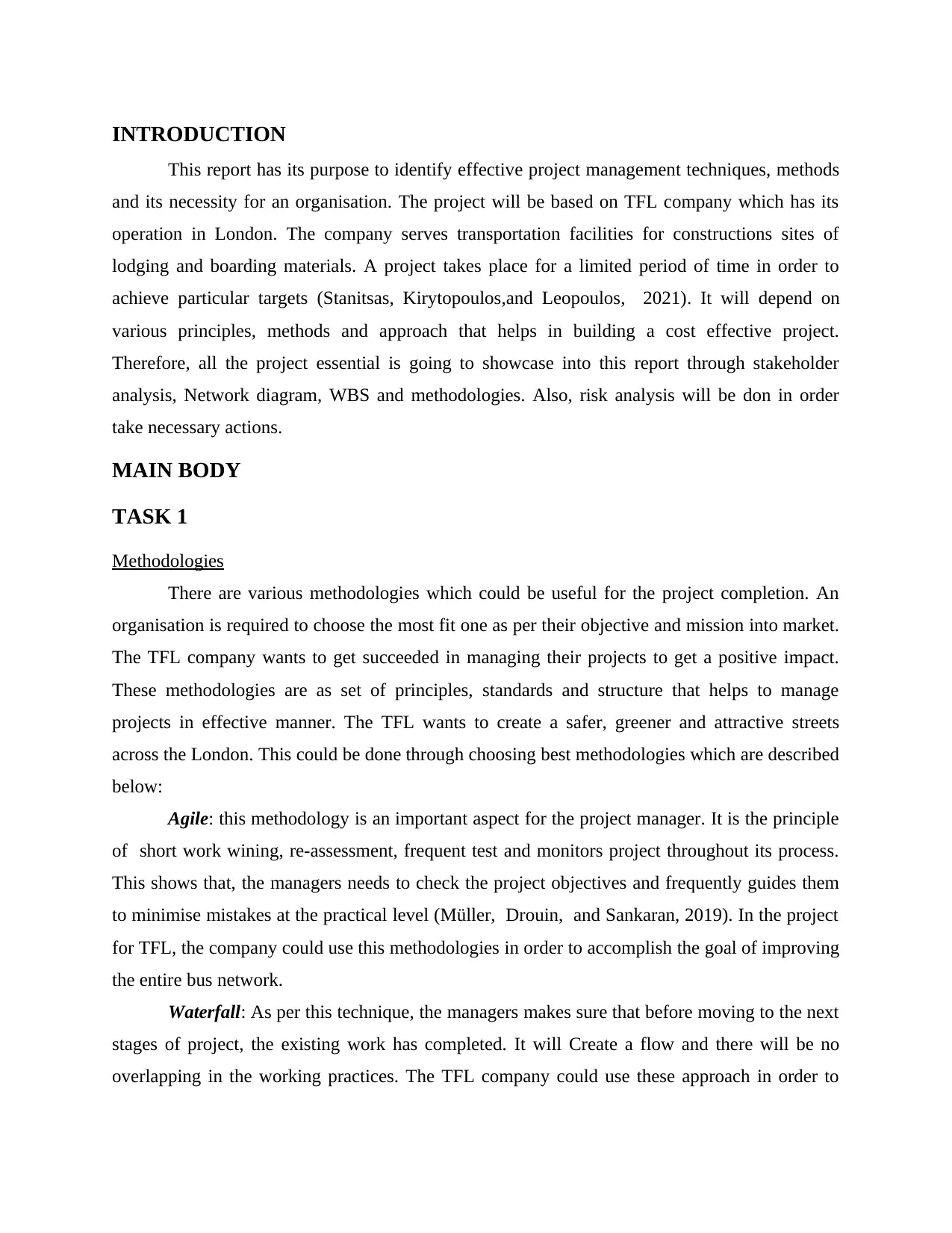
INTRODUCTION
This report has its purpose to identify effective project management techniques, methods
and its necessity for an organisation. The project will be based on TFL company which has its
operation in London. The company serves transportation facilities for constructions sites of
lodging and boarding materials. A project takes place for a limited period of time in order to
achieve particular targets (Stanitsas, Kirytopoulos,and Leopoulos, 2021). It will depend on
various principles, methods and approach that helps in building a cost effective project.
Therefore, all the project essential is going to showcase into this report through stakeholder
analysis, Network diagram, WBS and methodologies. Also, risk analysis will be don in order
take necessary actions.
MAIN BODY
TASK 1
Methodologies
There are various methodologies which could be useful for the project completion. An
organisation is required to choose the most fit one as per their objective and mission into market.
The TFL company wants to get succeeded in managing their projects to get a positive impact.
These methodologies are as set of principles, standards and structure that helps to manage
projects in effective manner. The TFL wants to create a safer, greener and attractive streets
across the London. This could be done through choosing best methodologies which are described
below:
Agile: this methodology is an important aspect for the project manager. It is the principle
of short work wining, re-assessment, frequent test and monitors project throughout its process.
This shows that, the managers needs to check the project objectives and frequently guides them
to minimise mistakes at the practical level (Müller, Drouin, and Sankaran, 2019). In the project
for TFL, the company could use this methodologies in order to accomplish the goal of improving
the entire bus network.
Waterfall: As per this technique, the managers makes sure that before moving to the next
stages of project, the existing work has completed. It will Create a flow and there will be no
overlapping in the working practices. The TFL company could use these approach in order to
This report has its purpose to identify effective project management techniques, methods
and its necessity for an organisation. The project will be based on TFL company which has its
operation in London. The company serves transportation facilities for constructions sites of
lodging and boarding materials. A project takes place for a limited period of time in order to
achieve particular targets (Stanitsas, Kirytopoulos,and Leopoulos, 2021). It will depend on
various principles, methods and approach that helps in building a cost effective project.
Therefore, all the project essential is going to showcase into this report through stakeholder
analysis, Network diagram, WBS and methodologies. Also, risk analysis will be don in order
take necessary actions.
MAIN BODY
TASK 1
Methodologies
There are various methodologies which could be useful for the project completion. An
organisation is required to choose the most fit one as per their objective and mission into market.
The TFL company wants to get succeeded in managing their projects to get a positive impact.
These methodologies are as set of principles, standards and structure that helps to manage
projects in effective manner. The TFL wants to create a safer, greener and attractive streets
across the London. This could be done through choosing best methodologies which are described
below:
Agile: this methodology is an important aspect for the project manager. It is the principle
of short work wining, re-assessment, frequent test and monitors project throughout its process.
This shows that, the managers needs to check the project objectives and frequently guides them
to minimise mistakes at the practical level (Müller, Drouin, and Sankaran, 2019). In the project
for TFL, the company could use this methodologies in order to accomplish the goal of improving
the entire bus network.
Waterfall: As per this technique, the managers makes sure that before moving to the next
stages of project, the existing work has completed. It will Create a flow and there will be no
overlapping in the working practices. The TFL company could use these approach in order to
⊘ This is a preview!⊘
Do you want full access?
Subscribe today to unlock all pages.

Trusted by 1+ million students worldwide
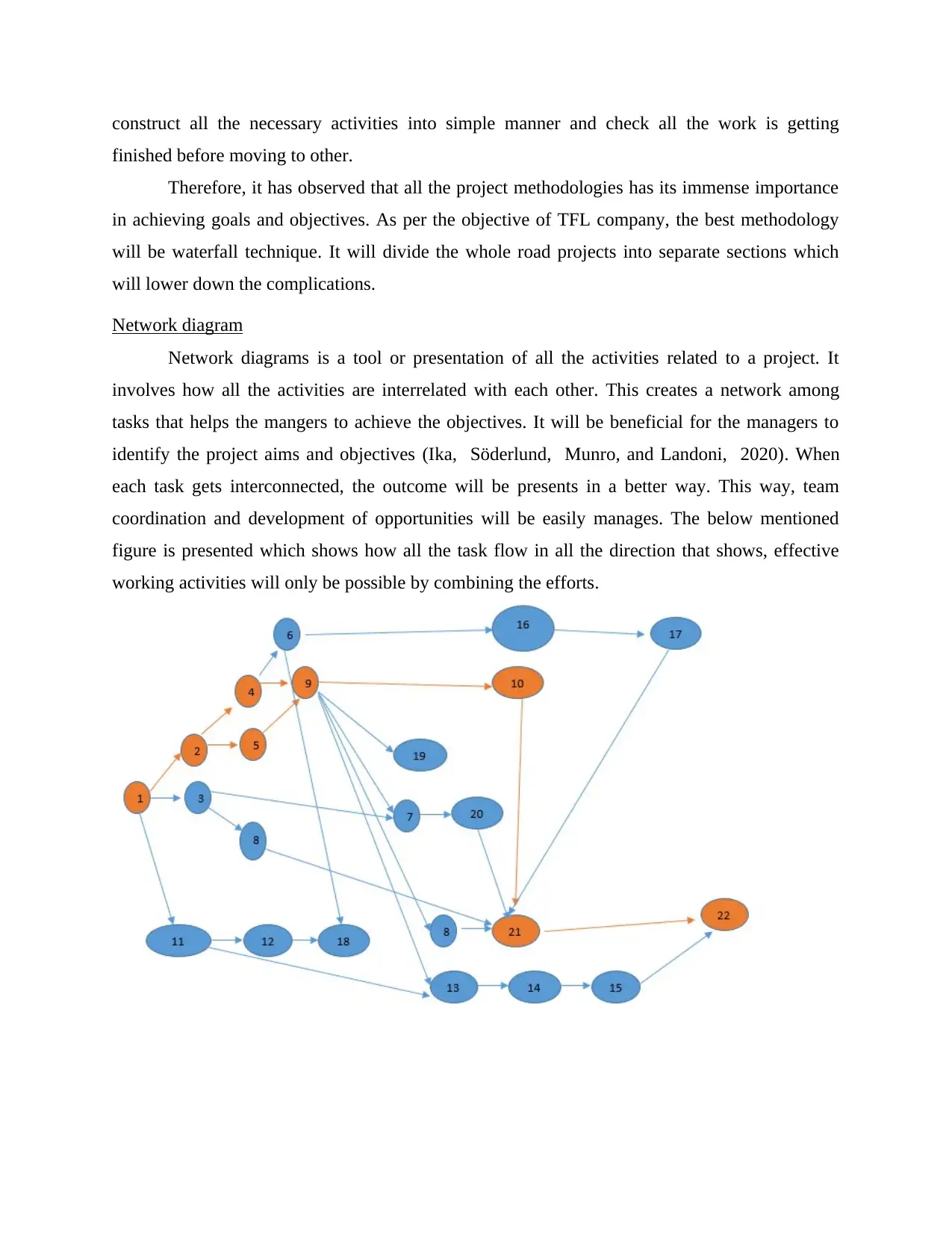
construct all the necessary activities into simple manner and check all the work is getting
finished before moving to other.
Therefore, it has observed that all the project methodologies has its immense importance
in achieving goals and objectives. As per the objective of TFL company, the best methodology
will be waterfall technique. It will divide the whole road projects into separate sections which
will lower down the complications.
Network diagram
Network diagrams is a tool or presentation of all the activities related to a project. It
involves how all the activities are interrelated with each other. This creates a network among
tasks that helps the mangers to achieve the objectives. It will be beneficial for the managers to
identify the project aims and objectives (Ika, Söderlund, Munro, and Landoni, 2020). When
each task gets interconnected, the outcome will be presents in a better way. This way, team
coordination and development of opportunities will be easily manages. The below mentioned
figure is presented which shows how all the task flow in all the direction that shows, effective
working activities will only be possible by combining the efforts.
finished before moving to other.
Therefore, it has observed that all the project methodologies has its immense importance
in achieving goals and objectives. As per the objective of TFL company, the best methodology
will be waterfall technique. It will divide the whole road projects into separate sections which
will lower down the complications.
Network diagram
Network diagrams is a tool or presentation of all the activities related to a project. It
involves how all the activities are interrelated with each other. This creates a network among
tasks that helps the mangers to achieve the objectives. It will be beneficial for the managers to
identify the project aims and objectives (Ika, Söderlund, Munro, and Landoni, 2020). When
each task gets interconnected, the outcome will be presents in a better way. This way, team
coordination and development of opportunities will be easily manages. The below mentioned
figure is presented which shows how all the task flow in all the direction that shows, effective
working activities will only be possible by combining the efforts.
Paraphrase This Document
Need a fresh take? Get an instant paraphrase of this document with our AI Paraphraser
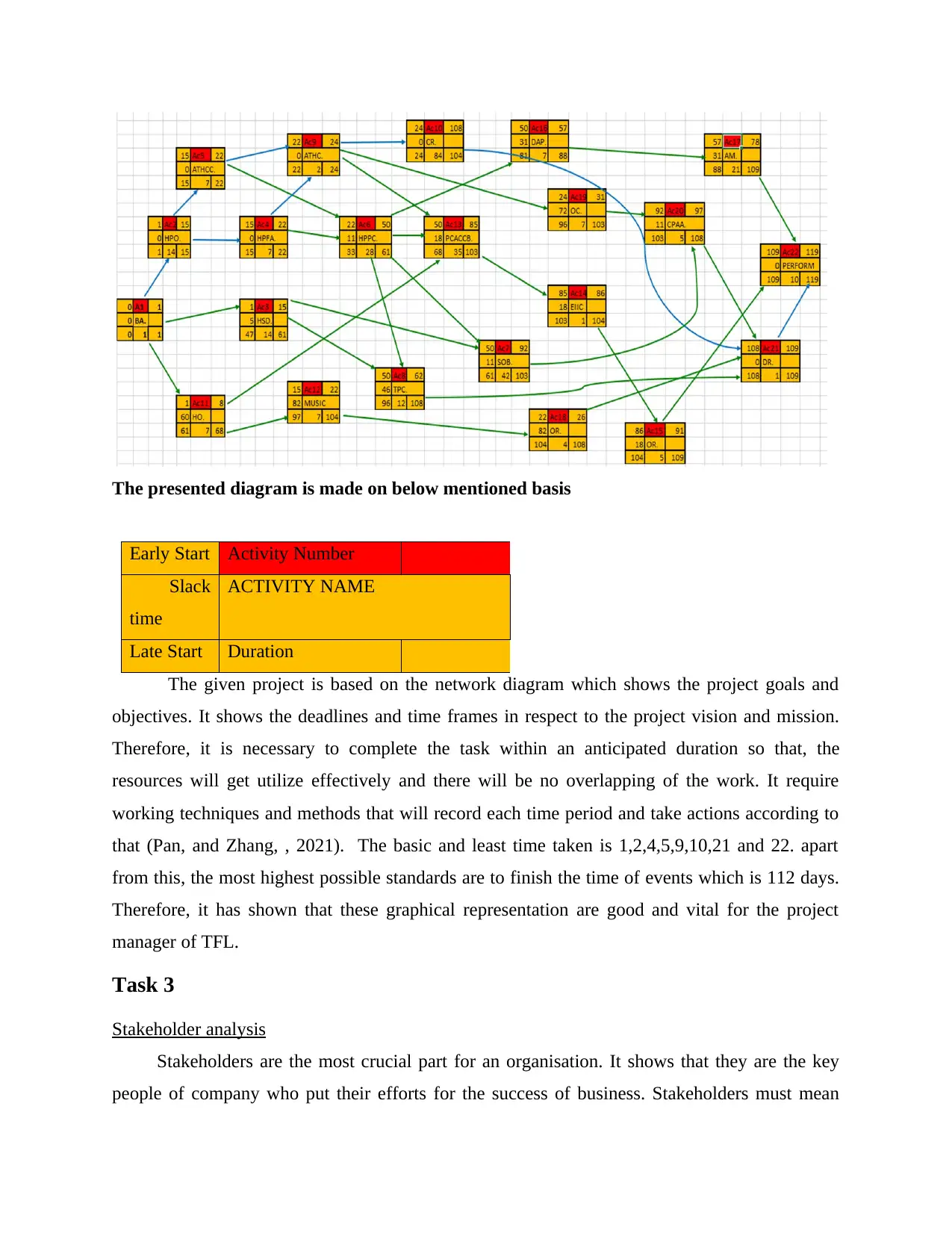
The presented diagram is made on below mentioned basis
Early Start Activity Number
Slack
time
ACTIVITY NAME
Late Start Duration
The given project is based on the network diagram which shows the project goals and
objectives. It shows the deadlines and time frames in respect to the project vision and mission.
Therefore, it is necessary to complete the task within an anticipated duration so that, the
resources will get utilize effectively and there will be no overlapping of the work. It require
working techniques and methods that will record each time period and take actions according to
that (Pan, and Zhang, , 2021). The basic and least time taken is 1,2,4,5,9,10,21 and 22. apart
from this, the most highest possible standards are to finish the time of events which is 112 days.
Therefore, it has shown that these graphical representation are good and vital for the project
manager of TFL.
Task 3
Stakeholder analysis
Stakeholders are the most crucial part for an organisation. It shows that they are the key
people of company who put their efforts for the success of business. Stakeholders must mean
Early Start Activity Number
Slack
time
ACTIVITY NAME
Late Start Duration
The given project is based on the network diagram which shows the project goals and
objectives. It shows the deadlines and time frames in respect to the project vision and mission.
Therefore, it is necessary to complete the task within an anticipated duration so that, the
resources will get utilize effectively and there will be no overlapping of the work. It require
working techniques and methods that will record each time period and take actions according to
that (Pan, and Zhang, , 2021). The basic and least time taken is 1,2,4,5,9,10,21 and 22. apart
from this, the most highest possible standards are to finish the time of events which is 112 days.
Therefore, it has shown that these graphical representation are good and vital for the project
manager of TFL.
Task 3
Stakeholder analysis
Stakeholders are the most crucial part for an organisation. It shows that they are the key
people of company who put their efforts for the success of business. Stakeholders must mean
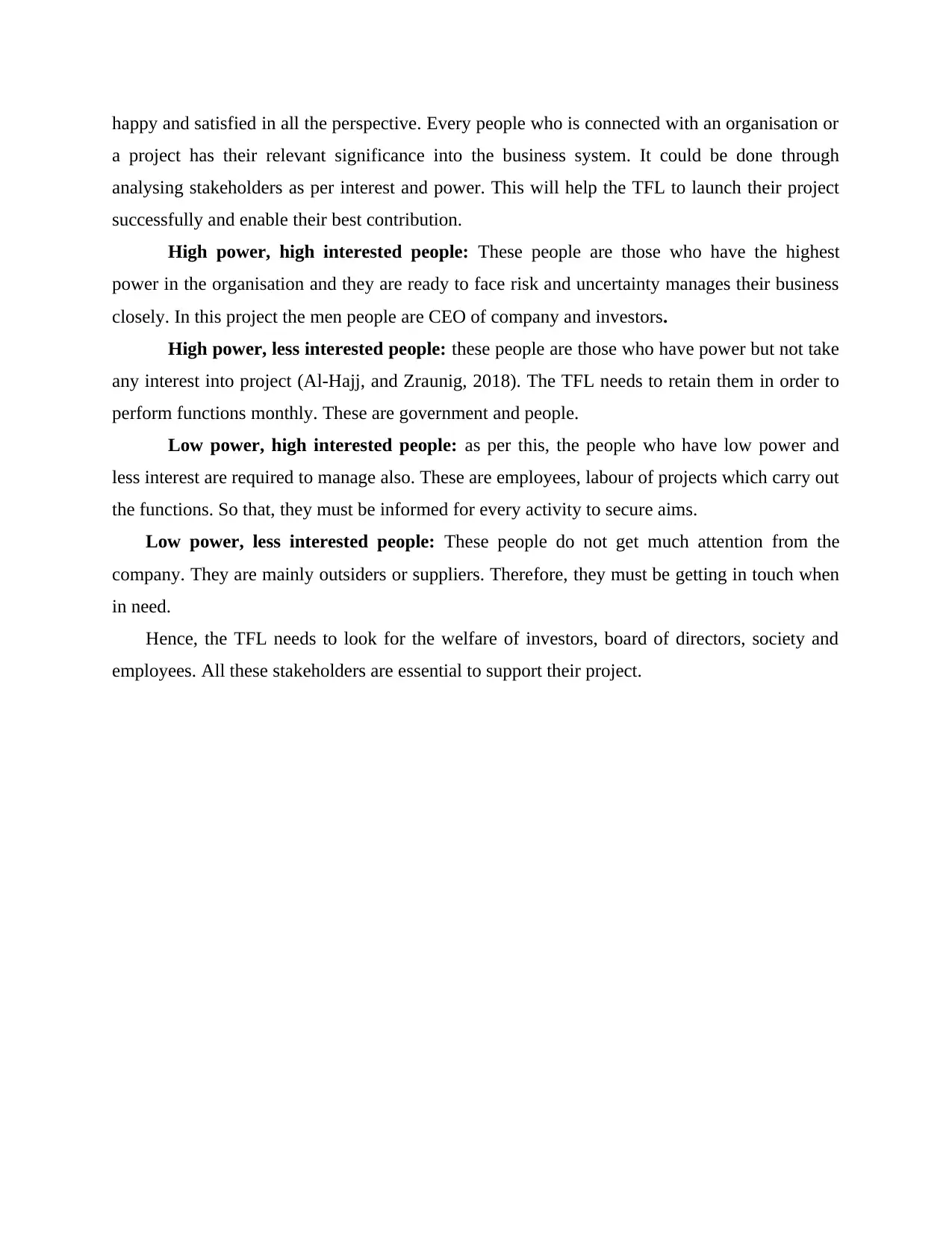
happy and satisfied in all the perspective. Every people who is connected with an organisation or
a project has their relevant significance into the business system. It could be done through
analysing stakeholders as per interest and power. This will help the TFL to launch their project
successfully and enable their best contribution.
High power, high interested people: These people are those who have the highest
power in the organisation and they are ready to face risk and uncertainty manages their business
closely. In this project the men people are CEO of company and investors.
High power, less interested people: these people are those who have power but not take
any interest into project (Al-Hajj, and Zraunig, 2018). The TFL needs to retain them in order to
perform functions monthly. These are government and people.
Low power, high interested people: as per this, the people who have low power and
less interest are required to manage also. These are employees, labour of projects which carry out
the functions. So that, they must be informed for every activity to secure aims.
Low power, less interested people: These people do not get much attention from the
company. They are mainly outsiders or suppliers. Therefore, they must be getting in touch when
in need.
Hence, the TFL needs to look for the welfare of investors, board of directors, society and
employees. All these stakeholders are essential to support their project.
a project has their relevant significance into the business system. It could be done through
analysing stakeholders as per interest and power. This will help the TFL to launch their project
successfully and enable their best contribution.
High power, high interested people: These people are those who have the highest
power in the organisation and they are ready to face risk and uncertainty manages their business
closely. In this project the men people are CEO of company and investors.
High power, less interested people: these people are those who have power but not take
any interest into project (Al-Hajj, and Zraunig, 2018). The TFL needs to retain them in order to
perform functions monthly. These are government and people.
Low power, high interested people: as per this, the people who have low power and
less interest are required to manage also. These are employees, labour of projects which carry out
the functions. So that, they must be informed for every activity to secure aims.
Low power, less interested people: These people do not get much attention from the
company. They are mainly outsiders or suppliers. Therefore, they must be getting in touch when
in need.
Hence, the TFL needs to look for the welfare of investors, board of directors, society and
employees. All these stakeholders are essential to support their project.
⊘ This is a preview!⊘
Do you want full access?
Subscribe today to unlock all pages.

Trusted by 1+ million students worldwide
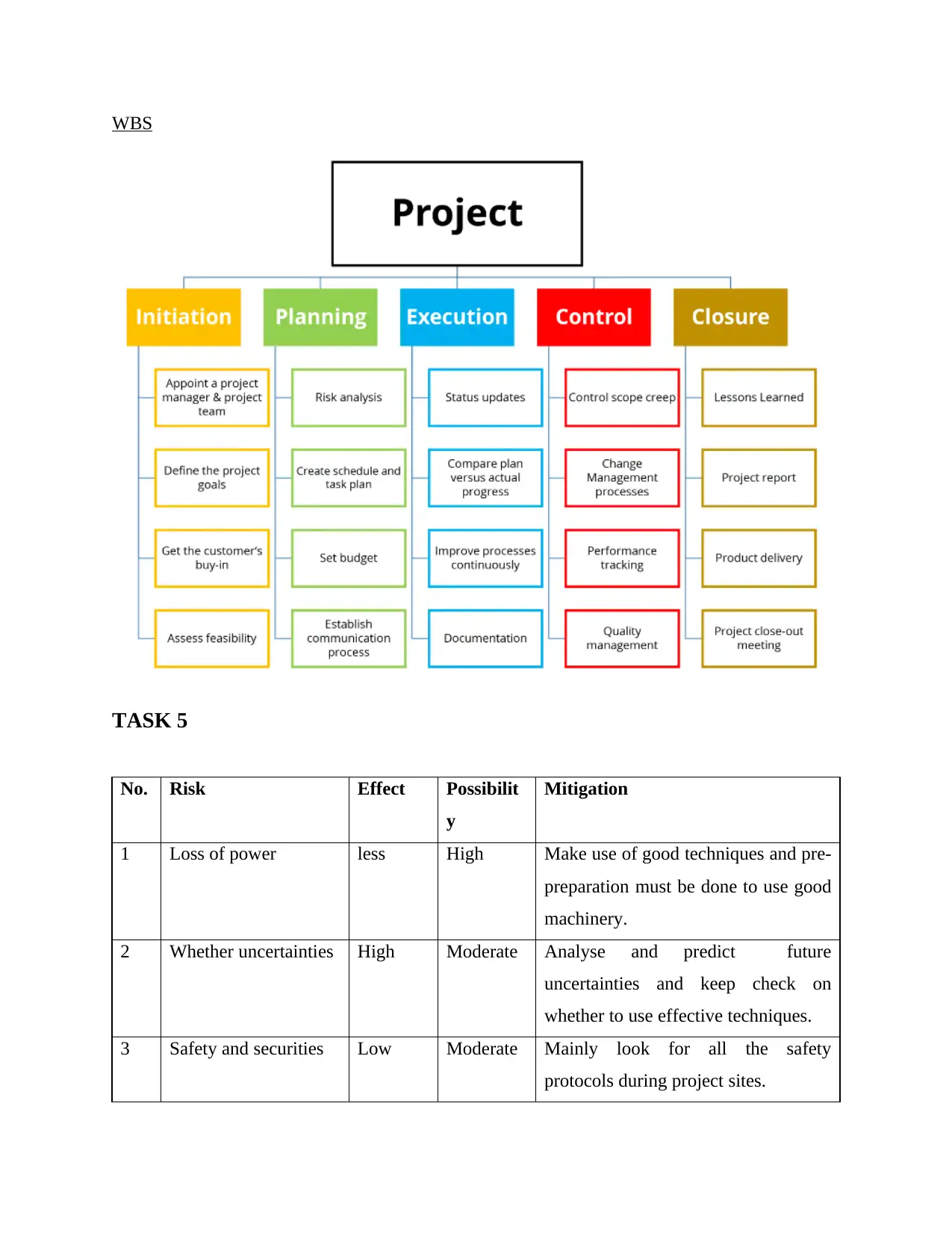
WBS
TASK 5
No. Risk Effect Possibilit
y
Mitigation
1 Loss of power less High Make use of good techniques and pre-
preparation must be done to use good
machinery.
2 Whether uncertainties High Moderate Analyse and predict future
uncertainties and keep check on
whether to use effective techniques.
3 Safety and securities Low Moderate Mainly look for all the safety
protocols during project sites.
TASK 5
No. Risk Effect Possibilit
y
Mitigation
1 Loss of power less High Make use of good techniques and pre-
preparation must be done to use good
machinery.
2 Whether uncertainties High Moderate Analyse and predict future
uncertainties and keep check on
whether to use effective techniques.
3 Safety and securities Low Moderate Mainly look for all the safety
protocols during project sites.
Paraphrase This Document
Need a fresh take? Get an instant paraphrase of this document with our AI Paraphraser
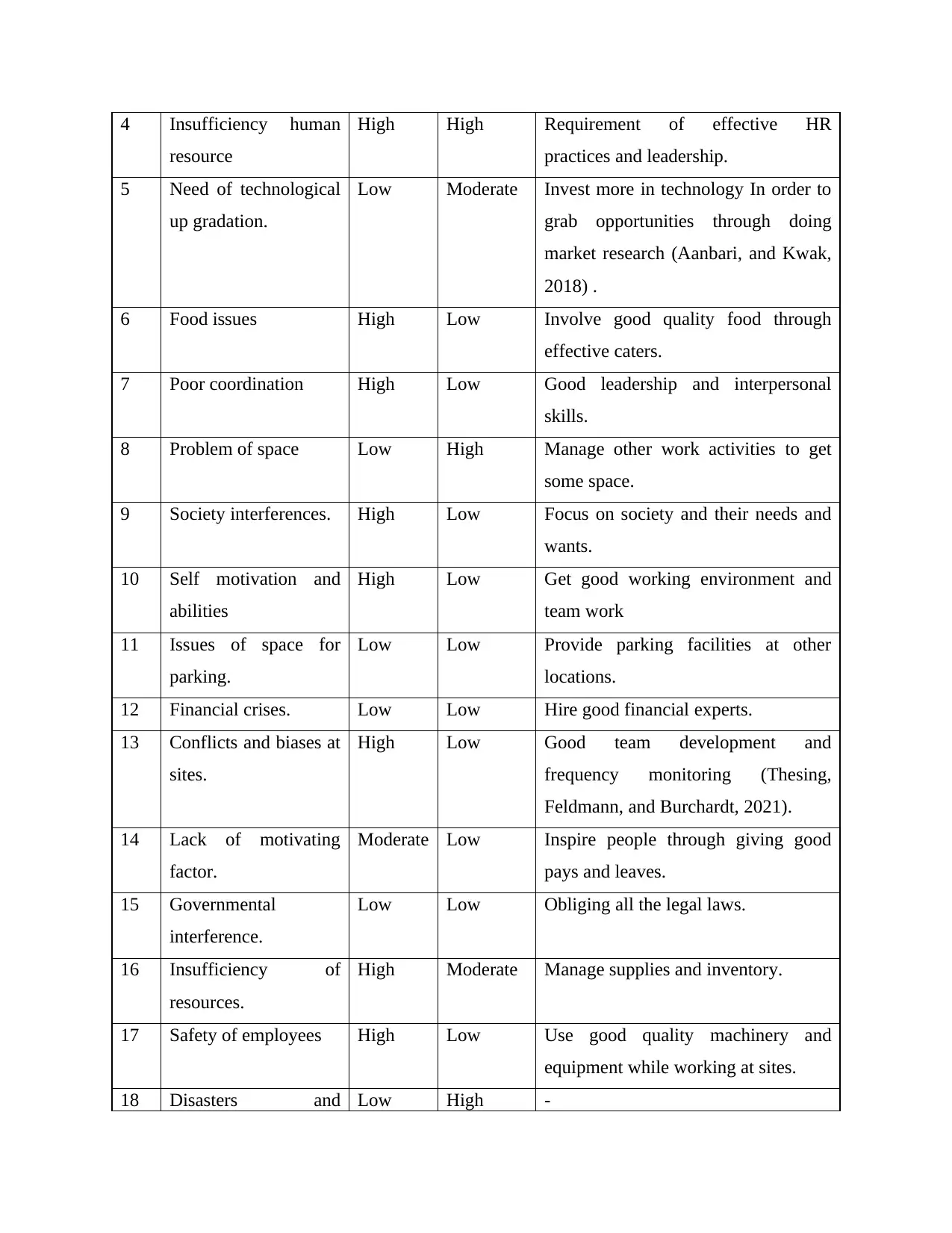
4 Insufficiency human
resource
High High Requirement of effective HR
practices and leadership.
5 Need of technological
up gradation.
Low Moderate Invest more in technology In order to
grab opportunities through doing
market research (Aanbari, and Kwak,
2018) .
6 Food issues High Low Involve good quality food through
effective caters.
7 Poor coordination High Low Good leadership and interpersonal
skills.
8 Problem of space Low High Manage other work activities to get
some space.
9 Society interferences. High Low Focus on society and their needs and
wants.
10 Self motivation and
abilities
High Low Get good working environment and
team work
11 Issues of space for
parking.
Low Low Provide parking facilities at other
locations.
12 Financial crises. Low Low Hire good financial experts.
13 Conflicts and biases at
sites.
High Low Good team development and
frequency monitoring (Thesing,
Feldmann, and Burchardt, 2021).
14 Lack of motivating
factor.
Moderate Low Inspire people through giving good
pays and leaves.
15 Governmental
interference.
Low Low Obliging all the legal laws.
16 Insufficiency of
resources.
High Moderate Manage supplies and inventory.
17 Safety of employees High Low Use good quality machinery and
equipment while working at sites.
18 Disasters and Low High -
resource
High High Requirement of effective HR
practices and leadership.
5 Need of technological
up gradation.
Low Moderate Invest more in technology In order to
grab opportunities through doing
market research (Aanbari, and Kwak,
2018) .
6 Food issues High Low Involve good quality food through
effective caters.
7 Poor coordination High Low Good leadership and interpersonal
skills.
8 Problem of space Low High Manage other work activities to get
some space.
9 Society interferences. High Low Focus on society and their needs and
wants.
10 Self motivation and
abilities
High Low Get good working environment and
team work
11 Issues of space for
parking.
Low Low Provide parking facilities at other
locations.
12 Financial crises. Low Low Hire good financial experts.
13 Conflicts and biases at
sites.
High Low Good team development and
frequency monitoring (Thesing,
Feldmann, and Burchardt, 2021).
14 Lack of motivating
factor.
Moderate Low Inspire people through giving good
pays and leaves.
15 Governmental
interference.
Low Low Obliging all the legal laws.
16 Insufficiency of
resources.
High Moderate Manage supplies and inventory.
17 Safety of employees High Low Use good quality machinery and
equipment while working at sites.
18 Disasters and Low High -
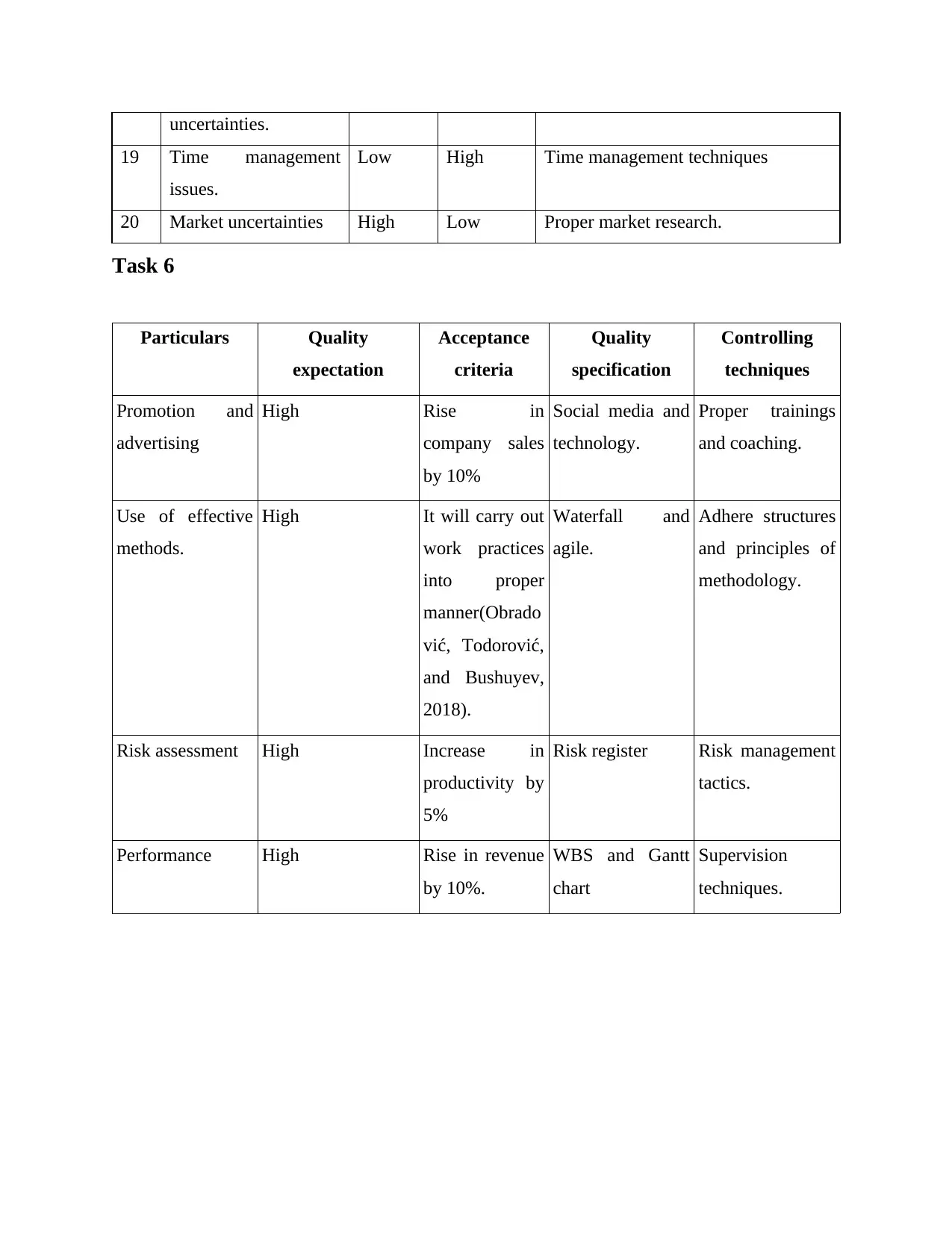
uncertainties.
19 Time management
issues.
Low High Time management techniques
20 Market uncertainties High Low Proper market research.
Task 6
Particulars Quality
expectation
Acceptance
criteria
Quality
specification
Controlling
techniques
Promotion and
advertising
High Rise in
company sales
by 10%
Social media and
technology.
Proper trainings
and coaching.
Use of effective
methods.
High It will carry out
work practices
into proper
manner(Obrado
vić, Todorović,
and Bushuyev,
2018).
Waterfall and
agile.
Adhere structures
and principles of
methodology.
Risk assessment High Increase in
productivity by
5%
Risk register Risk management
tactics.
Performance High Rise in revenue
by 10%.
WBS and Gantt
chart
Supervision
techniques.
19 Time management
issues.
Low High Time management techniques
20 Market uncertainties High Low Proper market research.
Task 6
Particulars Quality
expectation
Acceptance
criteria
Quality
specification
Controlling
techniques
Promotion and
advertising
High Rise in
company sales
by 10%
Social media and
technology.
Proper trainings
and coaching.
Use of effective
methods.
High It will carry out
work practices
into proper
manner(Obrado
vić, Todorović,
and Bushuyev,
2018).
Waterfall and
agile.
Adhere structures
and principles of
methodology.
Risk assessment High Increase in
productivity by
5%
Risk register Risk management
tactics.
Performance High Rise in revenue
by 10%.
WBS and Gantt
chart
Supervision
techniques.
⊘ This is a preview!⊘
Do you want full access?
Subscribe today to unlock all pages.

Trusted by 1+ million students worldwide
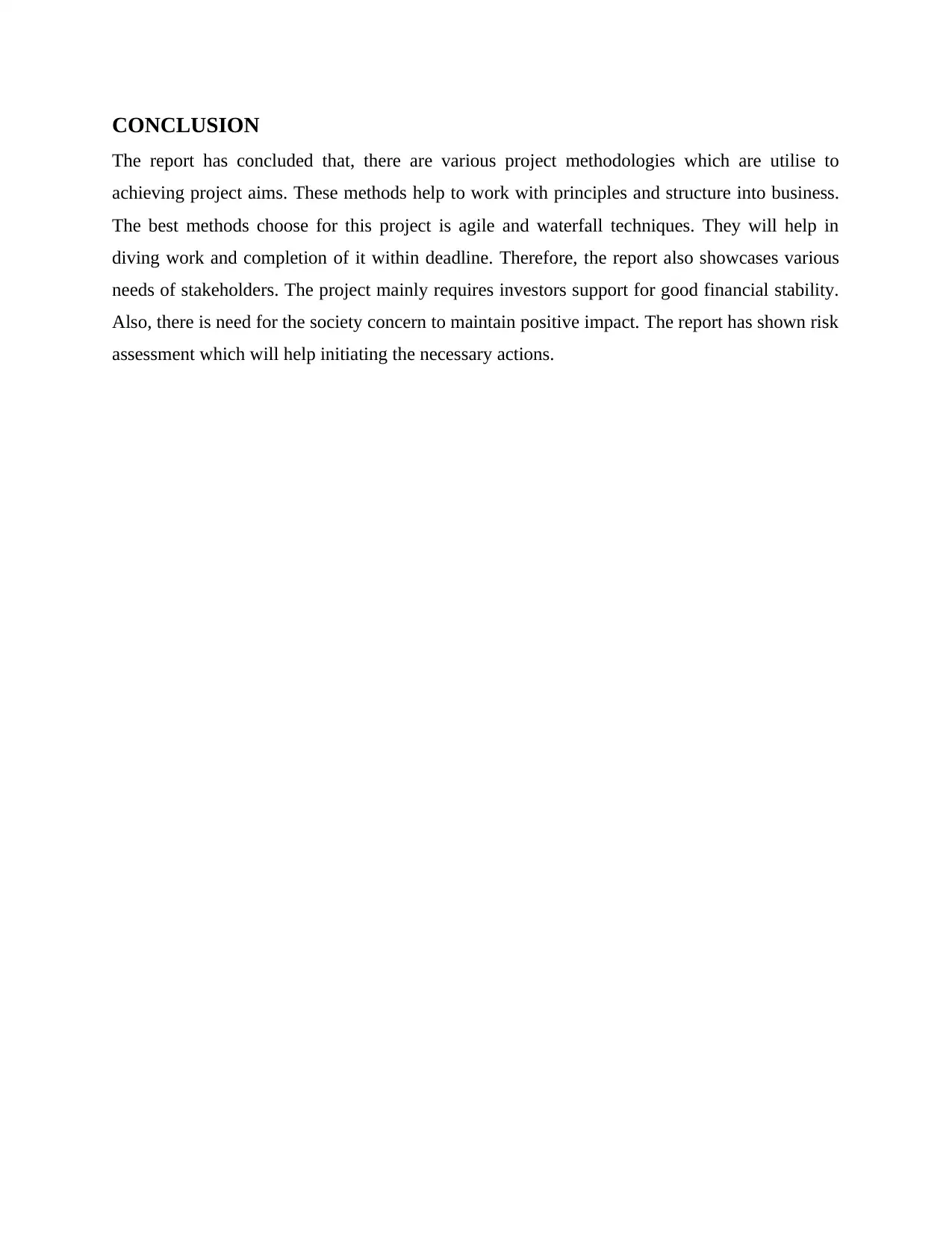
CONCLUSION
The report has concluded that, there are various project methodologies which are utilise to
achieving project aims. These methods help to work with principles and structure into business.
The best methods choose for this project is agile and waterfall techniques. They will help in
diving work and completion of it within deadline. Therefore, the report also showcases various
needs of stakeholders. The project mainly requires investors support for good financial stability.
Also, there is need for the society concern to maintain positive impact. The report has shown risk
assessment which will help initiating the necessary actions.
The report has concluded that, there are various project methodologies which are utilise to
achieving project aims. These methods help to work with principles and structure into business.
The best methods choose for this project is agile and waterfall techniques. They will help in
diving work and completion of it within deadline. Therefore, the report also showcases various
needs of stakeholders. The project mainly requires investors support for good financial stability.
Also, there is need for the society concern to maintain positive impact. The report has shown risk
assessment which will help initiating the necessary actions.
Paraphrase This Document
Need a fresh take? Get an instant paraphrase of this document with our AI Paraphraser
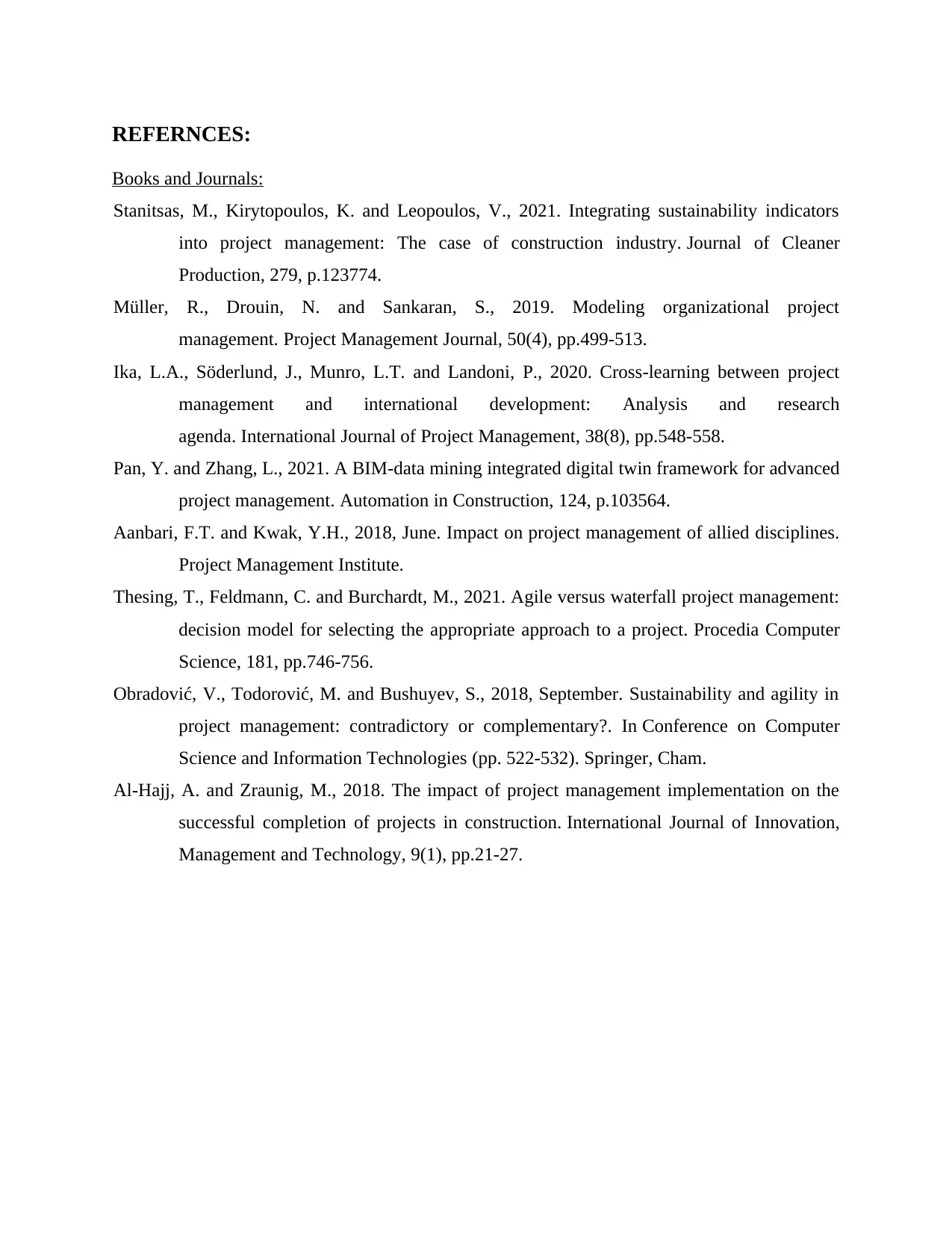
REFERNCES:
Books and Journals:
Stanitsas, M., Kirytopoulos, K. and Leopoulos, V., 2021. Integrating sustainability indicators
into project management: The case of construction industry. Journal of Cleaner
Production, 279, p.123774.
Müller, R., Drouin, N. and Sankaran, S., 2019. Modeling organizational project
management. Project Management Journal, 50(4), pp.499-513.
Ika, L.A., Söderlund, J., Munro, L.T. and Landoni, P., 2020. Cross-learning between project
management and international development: Analysis and research
agenda. International Journal of Project Management, 38(8), pp.548-558.
Pan, Y. and Zhang, L., 2021. A BIM-data mining integrated digital twin framework for advanced
project management. Automation in Construction, 124, p.103564.
Aanbari, F.T. and Kwak, Y.H., 2018, June. Impact on project management of allied disciplines.
Project Management Institute.
Thesing, T., Feldmann, C. and Burchardt, M., 2021. Agile versus waterfall project management:
decision model for selecting the appropriate approach to a project. Procedia Computer
Science, 181, pp.746-756.
Obradović, V., Todorović, M. and Bushuyev, S., 2018, September. Sustainability and agility in
project management: contradictory or complementary?. In Conference on Computer
Science and Information Technologies (pp. 522-532). Springer, Cham.
Al-Hajj, A. and Zraunig, M., 2018. The impact of project management implementation on the
successful completion of projects in construction. International Journal of Innovation,
Management and Technology, 9(1), pp.21-27.
Books and Journals:
Stanitsas, M., Kirytopoulos, K. and Leopoulos, V., 2021. Integrating sustainability indicators
into project management: The case of construction industry. Journal of Cleaner
Production, 279, p.123774.
Müller, R., Drouin, N. and Sankaran, S., 2019. Modeling organizational project
management. Project Management Journal, 50(4), pp.499-513.
Ika, L.A., Söderlund, J., Munro, L.T. and Landoni, P., 2020. Cross-learning between project
management and international development: Analysis and research
agenda. International Journal of Project Management, 38(8), pp.548-558.
Pan, Y. and Zhang, L., 2021. A BIM-data mining integrated digital twin framework for advanced
project management. Automation in Construction, 124, p.103564.
Aanbari, F.T. and Kwak, Y.H., 2018, June. Impact on project management of allied disciplines.
Project Management Institute.
Thesing, T., Feldmann, C. and Burchardt, M., 2021. Agile versus waterfall project management:
decision model for selecting the appropriate approach to a project. Procedia Computer
Science, 181, pp.746-756.
Obradović, V., Todorović, M. and Bushuyev, S., 2018, September. Sustainability and agility in
project management: contradictory or complementary?. In Conference on Computer
Science and Information Technologies (pp. 522-532). Springer, Cham.
Al-Hajj, A. and Zraunig, M., 2018. The impact of project management implementation on the
successful completion of projects in construction. International Journal of Innovation,
Management and Technology, 9(1), pp.21-27.
1 out of 11
Related Documents
Your All-in-One AI-Powered Toolkit for Academic Success.
+13062052269
info@desklib.com
Available 24*7 on WhatsApp / Email
![[object Object]](/_next/static/media/star-bottom.7253800d.svg)
Unlock your academic potential
Copyright © 2020–2025 A2Z Services. All Rights Reserved. Developed and managed by ZUCOL.


